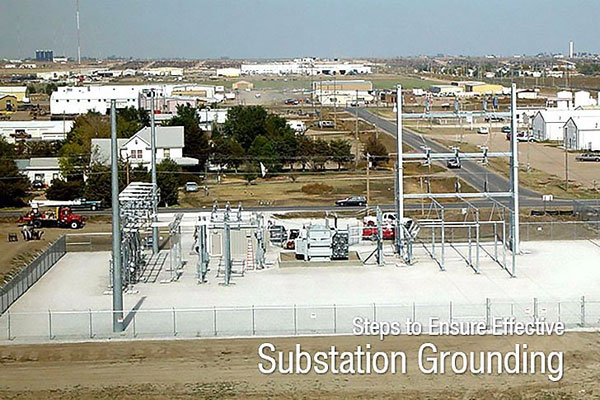
Substation Grounding Training - This 12-Hour live online instructor-led course will discuss how to maintain, test, and inspect a proper grounding system for high voltage transmission and distribution systems and especially the electrical power substation.
Safety remains a primary concern for substation owners, specifically in terms of protecting human life, and ensuring reliable network operation. Both electric utility and industrial substation equipment is protected by comprehensive grounding infrastructures. High voltage electrical grounding systems are subject to weathering, corrosion, damage and general wear. System integrity must be inspected and tested on a regular basis. Substation engineers must accurately assess the condition of grounding systems to ensure they are capable of dissipating additional fault current.
This substation grounding training course covers effective relaying and insulation of equipment; and also the safety of the personnel is the governing criterion through the proper design of substation grounding. This course will discuss how to maintain, test, and inspect a proper grounding system for the electrical power substation.
This substation grounding training course covers the ideas behind effective substation grounding system design and describes test methods and numerical models to characterize soil resistivity into a two layer soil model. Participants learn test methods to measure other important grounding system parameters, such as interconnected grounding impedance, neutral and over head ground wire current splits. Then, functional requirements of temporary working grounds are discussed followed by their installation configuration, maintenance and testing.
This course will provide the basic principles of grounding a power supply network to ensure safety of personnel and equipment. Understanding these principles will provide the correct tools to design a grounding system applicable to utility networks and industrial plant distribution. This course covers the basic procedures in working safely on medium and high voltage systems.
This Substation Grounding course will deal with all of these important issues.
After Attending, You Will Understand:
This course is designed for engineering project managers, engineers, and technicians from utilities who have built or are considering building or retrofitting substations or distribution systems with SCADA and substation integration and automation equipment.
Substation Grounding Training Course Outline
DAY ONE
ELECTRICAL HAZARDS FOR WORKERS
• Effect of current on a person from AC & DC Currents (IEEE 524a, IEEE 1048)
• Step and touch potentials
• Electric fields (capacitive coupling)
• Magnetic fields (inductive coupling)
• Preventing shock through isolation, insulation, equipment bonding
• Protection against inadvertent energization through Personal Protective Grounds (PPG)
• Arc flash hazards
ELECTRICAL SYSTEM GROUNDING OPTIONS
• Solidly grounded systems
• Low resistance or reactance grounding
• High resistance grounding
• Ungrounded systems
• Low-voltage systems grounding
• Ground fault circuit interrupters (GFCI)
• Distribution system grounding
• Transmission system grounding
PERSONAL PROTECTIVE GROUNDS (PPG)
• Use of PPG and procedures
• Single-point grounding compared to bracket grounding
• Sizing for PPG cables and PPG cable types
• PPG clamps – type, class, and grade (ASTM 855)
• PPG for various applications (busbar, wires, underground cables, switches, etc)
• Paralleling PPG
• Procedures for applying PPG
• Grounding capacitors and cables
• Grounding vehicles
• Testing PPG
SUBSTATION GROUNDING SYSTEMS
• Ground grid conductors
• Ground rods
• Soil and rock layers
• Connections to equipment and grounded tanks
• Connectors used for ground grid application (IEEE 837)
• Substation fence and gate grounding
• Ground grates and switch operating platforms
• Grounding transformer tanks and surge arresters
• Grounding wood and metal structures
• Use of line terminal grounding switches
• Lightning protection (shielding)
SUBSTATION LOW-VOLTAGE GROUNDING CONSIDERATIONS
• Grounding for substation DC circuits and batteries
• Grounding auxiliary power circuits
• Current transformer (CT) and voltage transformer (VT) grounding
• Communication circuit grounding
• Equipment enclosure grounding
DAY TWO
PREVENTING COPPER THEFT
• Safety considerations of substation copper theft
• Likely targets for copper thieves
• Security options (fencing, cameras, etc)
• Methods to limit amount of exposed copper
• Options for protecting exposed copper leads
DESIGNING SUBSTATION GROUND GRID SYSTEMS
• Determining maximum fault current available
• Soil resistivity
• Measuring soil resistivity
• Insulating rock layer
• Ground Potential Rise (GPR)
• Limiting step potentials
• Limiting touch potentials
SOFTWARE-AIDED DESIGN FOR SUBSTATION GROUND GRID SYSTEMS
• IEEE 80 calculations
• Input parameters needed
• Using software (WinIGS) for ground grid design
• Impacts of reducing or increasing grid dimensions
• Impacts of adding ground rods / ground wells
• Optimizing designs for safety and cost
SUBSTATION GROUND GRID TESTING
• Ground grid corrosion
• Measuring ground rod resistance
• Measuring substation grid resistance
• Equipment for ground grid verification
• Finding and repairing deteriorated ground connections
GROUNDING STANDARDS AND GUIDELINES
• IEEE 80, IEEE Guide for Safety in AC Substation Grounding
• ASTM F 855 Standard Specifications for Temporary Protective Grounds
• IEEE 1246, IEEE Guide for Temporary Protective Grounding Systems Used in Substations
• IEEE 1048, IEEE Guide for Protective Grounding of Power Lines
• FIST 5-1 Personal Protective Grounding for Electric Power Facilities (U.S.B.R.)
Review of expectations
Questions and Answers
COURSE TIMETABLE
Both days:
Start: 8:00 a.m.
Coffee Break: 10:00 a.m.
Lunch: 12:00 noon
Restart: 1:15 p.m.
Finish: 4:30 p.m.
The registration fee to attend this live online training course is $599 + GST/HST.
Click Here to download a $100 discount coupon that you can apply toward the regular registration fee and pay only $499 + GST/HST
Register 3 delegates at full price $599, and get a 4th registration FREE!
Successful completion of this course qualifies delegates to receive a certificate of course completion with indicated CEUs.
CEUs are granted by the Engineering Institute of Canada. One CEU is equivalent to 10 professional development hours of instruction.
This course earns 1.2 CEUs.